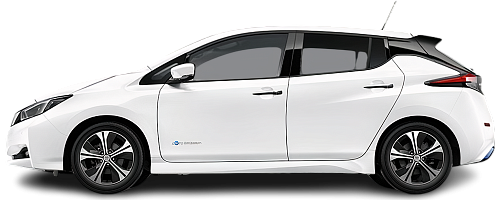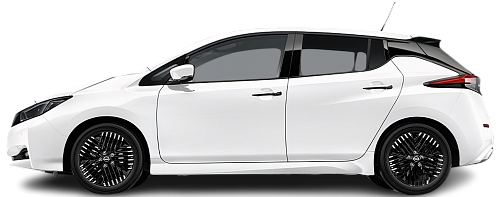Global EV Comparison: Nissan Leaf 62 kWh vs Leaf 60 kWh
Struggling to Decide? Let AI Help!
Your AI Summary Is Ready!
General Info
Since both vehicles have been discontinued, they are now only available on the used car market. You can get the Nissan Leaf 62 kWh (2017-2022) for as low as €16990, while the Nissan Leaf 60 kWh (2022-2025) begins at €20900.
The two vehicles share the same body style: Hatchback.
| Property | Nissan Leaf 62 kWh | Nissan Leaf 60 kWh |
|---|---|---|
| Years of Production | 2017-2022 | 2022-2025 |
| Current Status | Discontinued | Discontinued |
| Country of Manufacture | Japan, UK, USA | Japan, UK, USA |
| Body Style | Hatchback | Hatchback |
| Market Availability | EU, USA | EU, USA |
| Price Europe (Used) | €16990 | €20900 |
| GCC Score | 5.2 | 5 |
Range and Efficiency
Although both cars have the same battery capacity, Nissan Leaf 62 kWh (2017-2022) achieves a longer real-world range due to its superior energy efficiency.
| Property | Nissan Leaf 62 kWh | Nissan Leaf 60 kWh |
|---|---|---|
| Range (EPA) | 364 km | 341 km |
| Range (WLTP) | 385 km | 398 km |
| Range (GCC) | 337 km | 336 km |
| Battery Capacity (Nominal) | 62 kWh | 60 kWh |
| Battery Capacity (Usable) | 59 kWh | 59 kWh |
| Efficiency per 100 km | 17.5 kWh/100 km | 17.6 kWh/100 km |
| Efficiency per kWh | 5.71 km/kWh | 5.69 km/kWh |
| Range and Efficiency Score | 6.1 | 6.1 |
Charging
Both vehicles utilize a standard 400-volt architecture.
Both vehicles support DC fast charging with a maximum power of 100 kW.
Both vehicles are equipped with the same on-board charger, supporting a maximum AC charging power of 3.6 kW.
| Property | Nissan Leaf 62 kWh | Nissan Leaf 60 kWh |
|---|---|---|
| Max Charging Power (AC) | 3.6 kW | 3.6 kW |
| Max Charging Power (DC) | 100 kW | 100 kW |
| Architecture | 400 V | 400 V |
| Charge Port | CHAdeMO | CHAdeMO |
| Charging Score | 3.8 | 3.8 |
Performance
Both vehicles are front-wheel drive.
With equal motor power, both cars deliver the same 0-100 km/h acceleration time.
| Property | Nissan Leaf 62 kWh | Nissan Leaf 60 kWh |
|---|---|---|
| Drive Type | FWD | FWD |
| Motor Type | PMSM | PMSM |
| Motor Power (kW) | 160 kW | 160 kW |
| Motor Power (hp) | 215 hp | 215 hp |
| Motor Torque | 340 Nm | 340 Nm |
| 0-100 km/h | 7.1 s | 7.1 s |
| Top Speed | 157 km/h | 157 km/h |
| Performance Score | 3.6 | 3.6 |
Dimensions
The Nissan Leaf 62 kWh (2017-2022) and Nissan Leaf 60 kWh (2022-2025) are about the same size.
Both models have similar wheelbase lengths.
| Property | Nissan Leaf 62 kWh | Nissan Leaf 60 kWh |
|---|---|---|
| Length | 4490 mm | 4490 mm |
| Width (with Mirrors) | 2030 mm | 2030 mm |
| Width (w/o Mirrors) | 1788 mm | 1788 mm |
| Height | 1540 mm | 1540 mm |
| Wheelbase | 2700 mm | 2700 mm |
Cargo and Towing
Both models provide equal trunk space and the same total cargo volume when the rear seats are folded.
Neither car is equipped with a frunk (front trunk).
Neither vehicle is officially rated for towing in in the EU.
| Property | Nissan Leaf 62 kWh | Nissan Leaf 60 kWh |
|---|---|---|
| Number of Seats | 5 | 5 |
| Curb Weight | 1756 kg | 1756 kg |
| Cargo Volume (Trunk) | 426 l | 426 l |
| Cargo Volume (Max) | 1167 l | 1167 l |
| Cargo Volume (Frunk) | - Cargo Volume (Frunk) | - Cargo Volume (Frunk) |
| Towing Capacity | - Towing Capacity | - Towing Capacity |
| Cargo and Towing Score | 4.6 | 4.6 |




